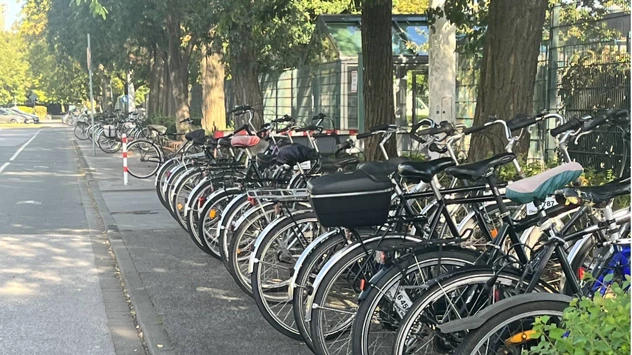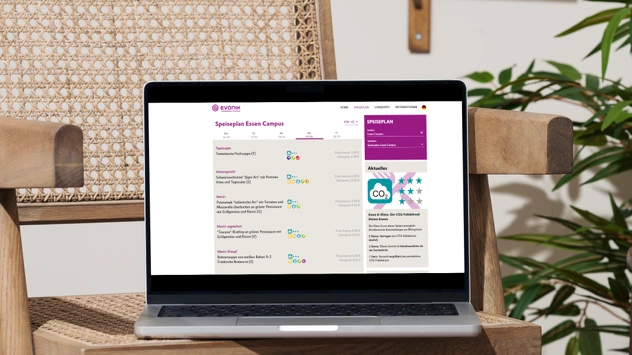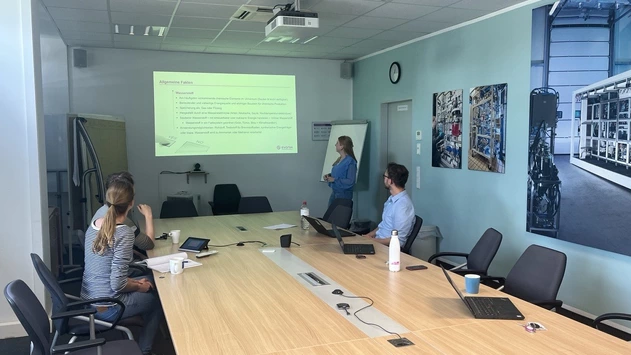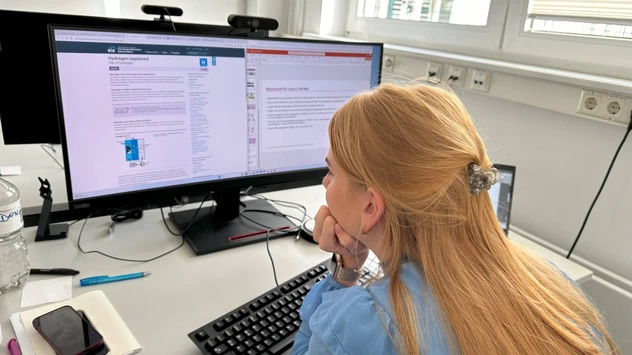
#3 – Sustainability in Numbers, Facts and Much More
The Green Journal: A day in the Life Cycle Management at Evonik. Exploring sustainability in numbers and beyond.
Welcome
Hi and welcome to my blog! I'm excited to tell you about my latest experiences and insights from the field of sustainability at Evonik. Now that you are ready, let's dive into the >> Sustainability in numbers, facts and much more >>!
I completed my second one-day-internship in the Life Cycle Management Team at the Marl Chemical Park. I would like to tell you more about my daily routine and my impressions of sustainable development in the chemical sector and at Evonik.
8:30am Start / Welcome & Breakfast

Chemiepark Marl

Meal plan and recorded star scale
The LCM team consists of 20 employees who are spread over two locations in Germany. Stefan and Timm are located in Marl and welcomed me. With its size of a small town – with up to 12,000 people working here! – it is of course very impressive and quite different from my other location, Essen Campus (800 employees). After check-in, we started with a breakfast in the canteen. Here we could get to know each other and discuss the rest of the day. A fun fact: Timm had won a breakfast for his team because he had taken part in a video for the canteen. This was about the star rating of the meals, because at Evonik all meals are given a star scale that says how climate-friendly this dish is, and with three stars the meal significantly reduces the CO2 footprint and thus contributes to the sustainable development of the environment.
9:00am Presentation of Life Cycle Management
To get an overview, Stefan explained some of the main topics of the LCM-Team to me. Here is a short overview for you:
1. Corporate carbon footprint
Here the LCM-Team calculates the Scope 3 (All indirect greenhouse gases of the upstream and downstream (value chain) of the Corporate Carbon Footprint, which is a company-wide balance of all greenhouse gas emissions. The company's emission reduction targets are then derived on the basis of these figures. Stefan then explained it to me again, so that I could think of it as a kind of financial balance sheet of emissions. Only with emission instead of euros.
2. Product Footprint (Life Cycle Assessments)
The product footprint is the result of the calculation of a life cycle assessment.
A life cycle assessment is used to quantify and evaluate the environmental impact of a product. Different Impacts can be assessed, such as the CO2 footprint and the water footprint.
3. Handprint Analysis
The third aspect initially caused me some confusion. Because this is about calculating the positive sustainability effects of Evonik products in application. And these effects are then compared to the respective established products in that application. But wait, didn't Susann explain something similar to me the other day? What is the difference to the Portfolio Sustainability Assessment (PSA)?
In the handprint analysis of the LCM, the effects on sustainability are calculated in a quantitative analysis. And in the PSA, this is then combined with the qualitative assessment and the subjective opinion of appointed experts. These are two ways of capturing the positive effects of products in their use.
4. Sustainability in chemical industry research
One last topic is the support of Longterm Process Innovation. This identifies and develops future processes and is the foundation for the great transformation at Evonik. This is where I saw the link to NextGen Technologies. The development of environmentally friendly and sustainable processes for the production of chemicals is one of the most significant factors for Green Chemistry and, looking into the future, for society.
10:30am Wiki Article | Topic Hydrogen
To contribute myself, Stefan and Timm commissioned me to write an article for the internal LCM Wiki. The LCM Wiki is a kind of Wikipedia for sustainability at Evonik. It is written by employees from the LCM-Team for employees at Evonik. The aim is to present relevant sustainability topics. The page is constantly developed and is updated regularly. My task was to do research on hydrogen in general. After the research and the preparation of a presentation, we used the time to discuss the further procedure. After the lunch break, I started to write down my information and to structure the article. At the end of the day, I was able to send a first draft to Timm and Stefan.

Presentation and Discussion about the Wiki Article

Research about Hydrogen
02:30pm Brainstorming on the Forum of New Employees (FoNeMa) - Cooperation USA
In the afternoon, we continued with a completely different topic related to the company's social responsibility in chemistry. This was the Forum of New Employees. The aim of this forum is to support new employees in the onboarding process through exchange with other colleagues so that they can build up their personal company network. Various events are coordinated and, for example, a speed networking takes place, where new employees can meet online and share their experiences, initial challenges and their area of responsibility.
To this end, Stefan is working in the coordinating various tasks outside of LCM's day-to-day business. On the same day, we had an appointment with colleagues from the USA to present the FoNeMa concept there and to get to know their concept. The aim or the wish is to create a link and to connect the colleagues globally.
I hope this has given you an insight into my day in the LCM-Team and a sense of how it promotes and influences sustainability issues at Evonik. After this day, I can say for myself that I was able to identify some interfaces to already known topics and thus make it my next task to deal more with the human factor at Evonik as a company in the chemical sector. I would like to find out to what extent this has an impact on economic success.
So look forward to my next contribution. Here I will deal with the third pillar "Next Generation Culture", look at the social side of the chemical industry and also show you how I have already been able to work here and where I see the special characteristics.
